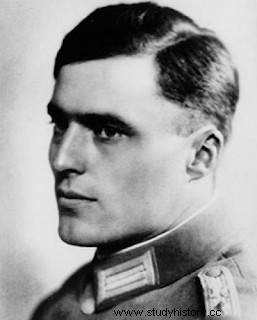Stauffenberg entered the meeting when it had already begun. He had asked for a seat close to Hitler due to his hearing problems. Shortly after arriving, Staufferbg made an excuse to get out of it, leaving his cap as a sign that he was coming back. It was something usual, but it caused strangeness because he had to intervene. After the explosion, Staufferberg and Haeften, not without some difficulties, left the compound and flew to Berlin. They were convinced that Hitler was dead.
At first, Hitler thought they were being bombed. when he detonated the bomb, there were 24 people in the barracks. The eleven who suffered the worst injuries were taken to the field hospital three kilometers away. Some died within a few hours, such as the stenographer H. Berger, Colonel H. Brandt or General G. Korten. the general R. Schmundt died in hospital a few weeks later from his injuries.
 |
But Hitler was still alive, he walked out of the rubble of the barracks on his own feet with his clothes in tatters and headed to his bunker. He had minor injuries:ruptured eardrums, a swollen right arm, bruises and scratches on his left arm, small cuts on his face, and some splinters and burns on his thighs. A series of coincidences saved Hitler's life, such as the fact that the meeting had been moved out of the bunker, that the bomb was left behind the thick leg of a table, that only one of the two planned explosives had been placed in Stauffenberg's bag. the detonator could have been activated or that the open windows deflected the blast wave. Hitler spoke of "Providence" when addressing the German people.
Hitler was furious at the betrayal of army commanders he had always trusted and decided to take a terrible revenge. From the very beginning, suspicion fell on the late Stauffenberg. A corporal remembered that a one-armed colonel had come out of the hut with a yellow briefcase.
In Berlin, the conspirators were nervous, no clear news arrived, for example they did not know if Hitler had survived or if Stauffenberg had been arrested. They did not know if they should launch Operation Valkyrie (use of the Reserve Army to neutralize Nazi leaders and units attached to Hitler, especially the SS and the Gestapo). The conspirators wasted a lot of time wondering what to do. Stauffnberg and the main conspirators were immediately arrested and shot by order of General Fromm, who was trying to erase evidence of his initial collusion with them. This speed that Hitler did not like.
Accused of complicity in the plot, 5,764 people were arrested in 1944 and as many in 1945, although less than a hundred knew what was going to happen.
 |
It is not clear who the conspirators represented. Churchill described them as "the bravest of the best ", but they were not the idealistic democrats that the cinema has portrayed, they were rather extreme German nationalists. Stauffenberg despised democracy, for him it was a lie that all men were equal; he believed in natural hierarchies and, therefore, he felt wrong to take the oath before Corporal Hitler. He was also a racist, in his part in the Poland campaign as a staff officer of a panzer division, he described the Poles as an unbelievable rabble of Jews and mestizos. Politically, he wanted Germany to return to the borders of 1939. For the solution of the German situation at that time, Stauffenber believed that there was no other way out than to kill Hitler. “Since the generals have done nothing so far, the colonels will have to take action ”
